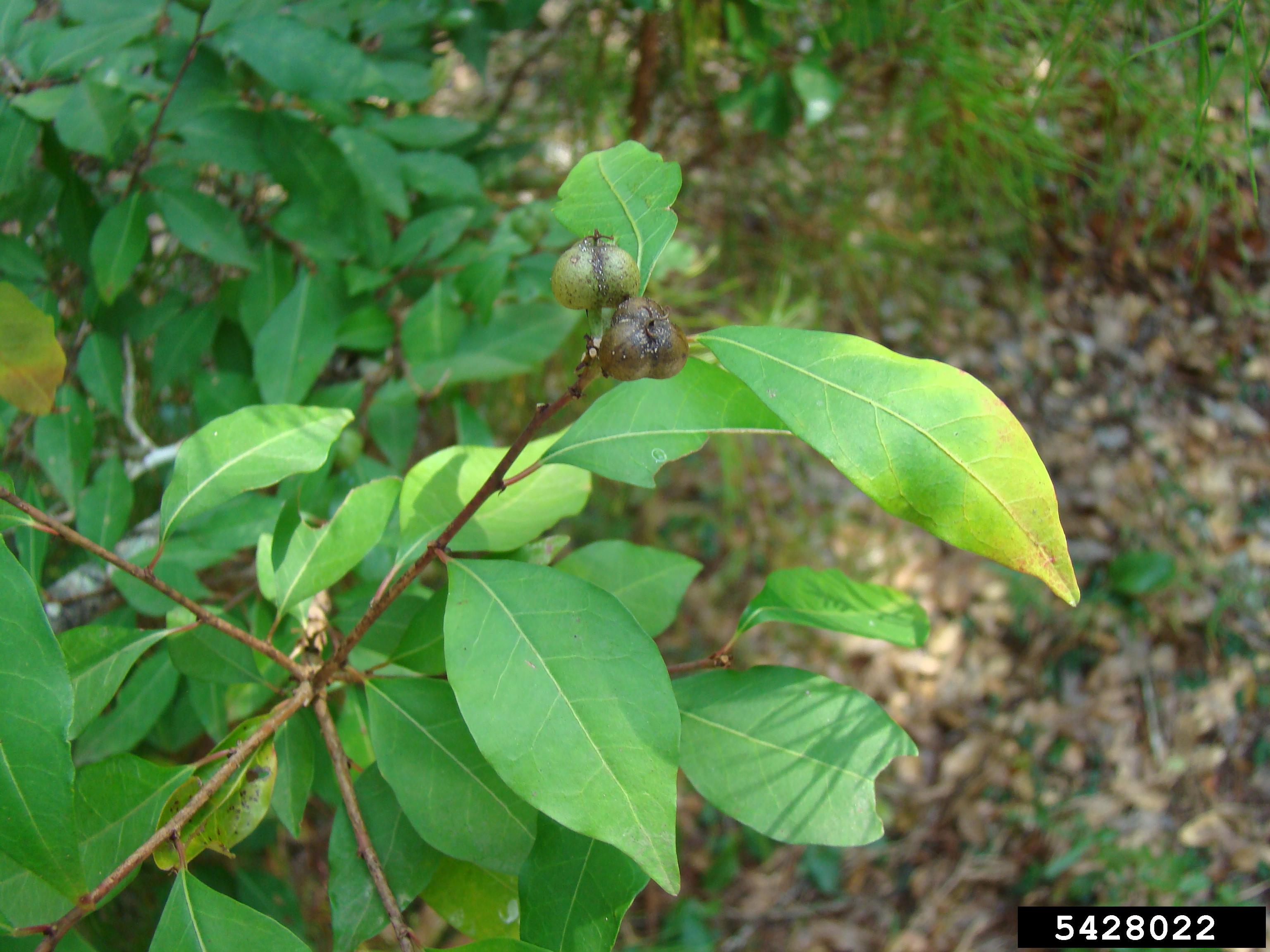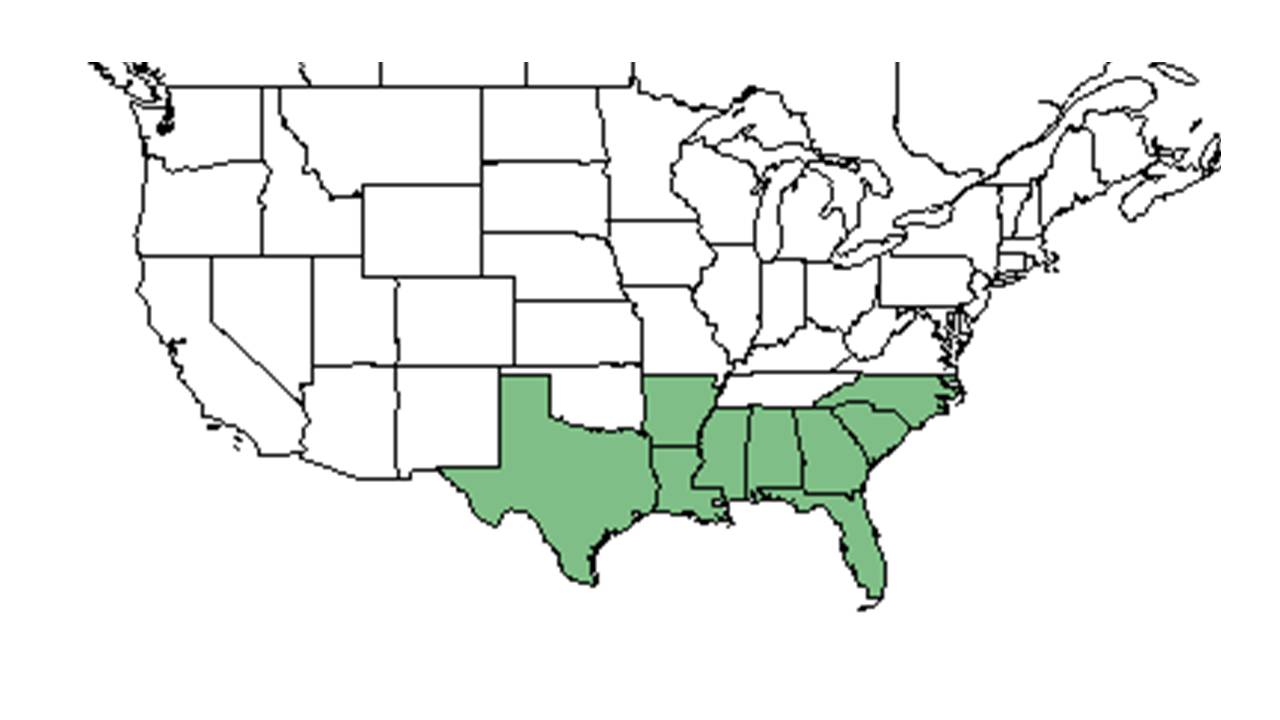Difference between revisions of "Ditrysinia fruticosa"
(→Ecology) |
|||
| Line 37: | Line 37: | ||
Generally, ''D. fruticosa'' can be found in swamp forests as well as other moist to wet and mostly shaded habitats.<ref name= "Weakley"/> It has been observed in dry and loamy sand of a mesic woodland, on a shaded hardwood slope, in a shaded swale with various wetland vegetation, in a river swamp, in a floodplain forest, and on a shaded limestone bluff.<ref name= "herbarium">Florida State University Robert K. Godfrey Herbarium database. URL: http://herbarium.bio.fsu.edu. Last accessed: May 2019. Collectors: Loran C. Anderson, A. Gholson, Jr., R. K. Godfrey, Neil Hotchkiss, R. Komarek, R. A. Norris, William J. Platt, Annie Schmidt, and Terry Williams. States and Counties: Florida: Gadsden, Jackson, Lafayette, Leon, and Liberty. Georgia: Grady and Thomas.</ref> This species is listed as facultative and facultative wetland, where it mostly occurs in wetland habitats, but can also quite commonly occur in non-wetland habitats.<ref name= "USDA">USDA, NRCS. (2016). The PLANTS Database (http://plants.usda.gov, 3 May 2019). National Plant Data Team, Greensboro, NC 27401-4901 USA.</ref> It is also a possible indicator of native groundcover and old fields of upland pine savannas in the Red Hills Region.<ref>Ostertag, T. E. and K. M. Robertson (2007). A comparison of native versus old-field vegetation in upland pinelands managed with frequent fire, south Georgia, USA. Proceedings of the 23rd Tall Timbers Fire Ecology Conference: Fire in Grassland and Shrubland Ecosystems, Tallahassee, Tall Timbers Research Station.</ref> | Generally, ''D. fruticosa'' can be found in swamp forests as well as other moist to wet and mostly shaded habitats.<ref name= "Weakley"/> It has been observed in dry and loamy sand of a mesic woodland, on a shaded hardwood slope, in a shaded swale with various wetland vegetation, in a river swamp, in a floodplain forest, and on a shaded limestone bluff.<ref name= "herbarium">Florida State University Robert K. Godfrey Herbarium database. URL: http://herbarium.bio.fsu.edu. Last accessed: May 2019. Collectors: Loran C. Anderson, A. Gholson, Jr., R. K. Godfrey, Neil Hotchkiss, R. Komarek, R. A. Norris, William J. Platt, Annie Schmidt, and Terry Williams. States and Counties: Florida: Gadsden, Jackson, Lafayette, Leon, and Liberty. Georgia: Grady and Thomas.</ref> This species is listed as facultative and facultative wetland, where it mostly occurs in wetland habitats, but can also quite commonly occur in non-wetland habitats.<ref name= "USDA">USDA, NRCS. (2016). The PLANTS Database (http://plants.usda.gov, 3 May 2019). National Plant Data Team, Greensboro, NC 27401-4901 USA.</ref> It is also a possible indicator of native groundcover and old fields of upland pine savannas in the Red Hills Region.<ref>Ostertag, T. E. and K. M. Robertson (2007). A comparison of native versus old-field vegetation in upland pinelands managed with frequent fire, south Georgia, USA. Proceedings of the 23rd Tall Timbers Fire Ecology Conference: Fire in Grassland and Shrubland Ecosystems, Tallahassee, Tall Timbers Research Station.</ref> | ||
| − | ''D. fruticosa'' | + | ''D. fruticosa'' has had mixed responses to agricultural disturbances in southwest Georgia. In some areas, its occurrence increased while in others it decreased in response to agricultural disturbance and reestablished native pinelands.<ref>Ostertag, T. E. and K. M. Robertson. 2007. A comparison of native versus old-field vegetation in upland pinelands managed with frequent fire, South Georgia, USA. Tall Timbers Fire Ecology Conference Proceedings 23: 109-120.</ref> It was also found to have variable changes in frequency in response to disturbance by KG blade in eastern Texas. ''D. fruticosa'' has shown a mix of regrowth and resistance to regrowth in reestablished native hardwood forests that were disturbed by KG blade. Additionally, it was found to have a decreased frequency in response to disturbance by roller chopping in eastern Texas. It has shown resistance to regrowth in reestablished pinewood forests that were disturbed by this practice.<ref>Stransky, J.J., J.C. Huntley, and Wanda J. Risner. (1986). Net Community Production Dynamics in the Herb-Shrub Stratum of a Loblolly Pine-Hardwood Forest: Effects of CLearcutting and Site Preparation. Gen. Tech. Rep. SO-61. New Orleans, LA: U.S. Dept of Agriculture, Forest Service, Southern Forest Experiment Station. 11 p.</ref> |
Associated species: ''Ilex glabra'', ''Hypericum'' sp., ''Carex glaucescens'', and other wetland species.<ref name= "herbarium"/> | Associated species: ''Ilex glabra'', ''Hypericum'' sp., ''Carex glaucescens'', and other wetland species.<ref name= "herbarium"/> | ||
Revision as of 20:06, 21 June 2021
| Ditrysinia fruticosa | |
|---|---|

| |
| Photo by Rebekah D. Wallace, University of Georgia, Bugwood.org | |
| Scientific classification | |
| Kingdom: | Plantae |
| Division: | Magnoliophyta - Flowering plants |
| Class: | Magnoliopsida – Dicotyledons |
| Order: | Euphorbiales |
| Family: | Euphorbiaceae |
| Genus: | Ditrysinia |
| Species: | D. fruticosa |
| Binomial name | |
| Ditrysinia fruticosa (W. Bartram) Govaerts & Frodin | |

| |
| Natural range of Ditrysinia fruticosa from USDA NRCS Plants Database. | |
Common name: Gulf Sebastian-bush
Contents
Taxonomic notes
Synonyms: Sebastiania fruticosa (W. Bartram) Fernald; Sebastiania ligustrina (Michaux) Müller of Aargau.[1]
Varieties: none.[1]
Description
D. fruticosa is a perennial shrub/subshrub that is a member of the Euphorbiaceae family.[2]
This description was published in 1964 stating, Ditrysinia fruticosa is a "monoecious shrub, 1.5-2.5 m tall. Leaves alternate, elliptic to lance-elliptic, 3-7.5 cm long, 0.8-3.5 cm wide, entire; petioles 2-10 mm long, ciliate toward apex and on base of blade, with a pair of glandular stipules at base. Racemes 1-4 cm long, pistillate flowers 1-5 at the base, staminate numerous above. Sepals 3; petals absent; stamens 3; stigmas 3. Each flower subtended by a bract, on each side of which occurs a large gland. Capsule 3-locular, 6-6.5 mm long, broader than long. Seeds light brown, ovoid, 4.5-5 mm long; caruncle obsolete."[3]
Distribution
D. fruticosa is native to the southeastern coastal plain from southeast North Carolina south to central peninsular Florida and west to eastern Texas.[4]
Ecology
Habitat
Generally, D. fruticosa can be found in swamp forests as well as other moist to wet and mostly shaded habitats.[4] It has been observed in dry and loamy sand of a mesic woodland, on a shaded hardwood slope, in a shaded swale with various wetland vegetation, in a river swamp, in a floodplain forest, and on a shaded limestone bluff.[5] This species is listed as facultative and facultative wetland, where it mostly occurs in wetland habitats, but can also quite commonly occur in non-wetland habitats.[2] It is also a possible indicator of native groundcover and old fields of upland pine savannas in the Red Hills Region.[6]
D. fruticosa has had mixed responses to agricultural disturbances in southwest Georgia. In some areas, its occurrence increased while in others it decreased in response to agricultural disturbance and reestablished native pinelands.[7] It was also found to have variable changes in frequency in response to disturbance by KG blade in eastern Texas. D. fruticosa has shown a mix of regrowth and resistance to regrowth in reestablished native hardwood forests that were disturbed by KG blade. Additionally, it was found to have a decreased frequency in response to disturbance by roller chopping in eastern Texas. It has shown resistance to regrowth in reestablished pinewood forests that were disturbed by this practice.[8]
Associated species: Ilex glabra, Hypericum sp., Carex glaucescens, and other wetland species.[5]
Phenology
This species can be seen to flower from May until June and fruit from July to October.[4] It has been observed to flower from March to June with peak inflorescence in April and May.[9]
Conservation, cultivation, and restoration
D. fruticosa is critically imperiled in Arkansas and imperiled in North Carolina.[10]
Cultural use
Photo Gallery
References and notes
- ↑ 1.0 1.1 Weakley, A.S. 2015. Flora of the southern and mid-atlantic states. Working Draft of 21 May 2015. University of North Carolina at Chapel Hill, Chapel Hill, North Carolina.
- ↑ 2.0 2.1 USDA, NRCS. (2016). The PLANTS Database (http://plants.usda.gov, 3 May 2019). National Plant Data Team, Greensboro, NC 27401-4901 USA.
- ↑ Radford, Albert E., Harry E. Ahles, and C. Ritchie Bell. Manual of the Vascular Flora of the Carolinas. 1964, 1968. The University of North Carolina Press. 667. Print.
- ↑ 4.0 4.1 4.2 Weakley, A. S. (2015). Flora of the Southern and Mid-Atlantic States. Chapel Hill, NC, University of North Carolina Herbarium.
- ↑ 5.0 5.1 Florida State University Robert K. Godfrey Herbarium database. URL: http://herbarium.bio.fsu.edu. Last accessed: May 2019. Collectors: Loran C. Anderson, A. Gholson, Jr., R. K. Godfrey, Neil Hotchkiss, R. Komarek, R. A. Norris, William J. Platt, Annie Schmidt, and Terry Williams. States and Counties: Florida: Gadsden, Jackson, Lafayette, Leon, and Liberty. Georgia: Grady and Thomas.
- ↑ Ostertag, T. E. and K. M. Robertson (2007). A comparison of native versus old-field vegetation in upland pinelands managed with frequent fire, south Georgia, USA. Proceedings of the 23rd Tall Timbers Fire Ecology Conference: Fire in Grassland and Shrubland Ecosystems, Tallahassee, Tall Timbers Research Station.
- ↑ Ostertag, T. E. and K. M. Robertson. 2007. A comparison of native versus old-field vegetation in upland pinelands managed with frequent fire, South Georgia, USA. Tall Timbers Fire Ecology Conference Proceedings 23: 109-120.
- ↑ Stransky, J.J., J.C. Huntley, and Wanda J. Risner. (1986). Net Community Production Dynamics in the Herb-Shrub Stratum of a Loblolly Pine-Hardwood Forest: Effects of CLearcutting and Site Preparation. Gen. Tech. Rep. SO-61. New Orleans, LA: U.S. Dept of Agriculture, Forest Service, Southern Forest Experiment Station. 11 p.
- ↑ Nelson, G. PanFlora: Plant data for the eastern United States with emphasis on the Southeastern Coastal Plains, Florida, and the Florida Panhandle. www.gilnelson.com/PanFlora/ Accessed: 3 MAY 2019
- ↑ [[1]] NatureServe Explorer. Accessed: May 3, 2019